Gas Gas Is Back In The Game
The Spanish, or more properly Catalan brand, has had a tumultuous history. Solid motorcycles mixed with the companies financial woes in a shaky economy led to bankruptcy, turnovers and near death for the company. Yet in 2016 Torrot Electric purchased the Gas Gas brand and placed enthusiast principles in key positions to get things pointed in the right direction. In the US, the brand has unified the trials and enduro motorcycle businesses, as well as the parts business as one with its ownership also under the Torrot company. And to top it all off there is now the introduction of an all-new EC and XC Enduro Racing bikes. Along with the new bikes the company has racing and demo plans so things are looking up. Dirt Bike Test attended the one-day US press introduction to get a feel for the new 300s and see where things are going.
Right from the first look at the 2018 bike in person, it looks smaller, slimmer, lighter and more agile. Just moving it around you can feel it is lighter, especially at the back of the bike. It now feels like a two-stroke in weight, not heavy like a four-stroke as the old bike did when pushing it or placing the bike on a stand. Those familiar with previous Gas Gas bikes will also notice a higher level of finish to the parts, specifically the welds on the frame and the hardware bolting it together.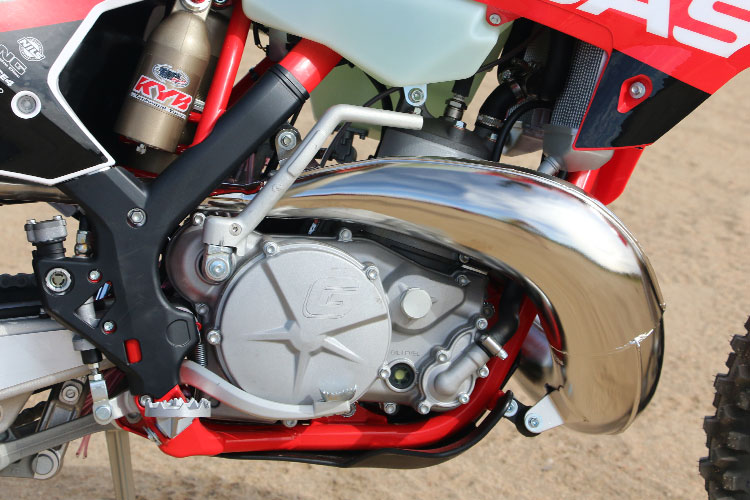
In the what’s new department, it would be easier to say what has not changed. Basically the engine cases and transmission stay the same, everything else is brand new. The engine has a new crankshaft and a redesigned cylinder and head for improved power. The ignition system is new and charges a lithium battery. The clutch is now controlled with a Magura master cylinder.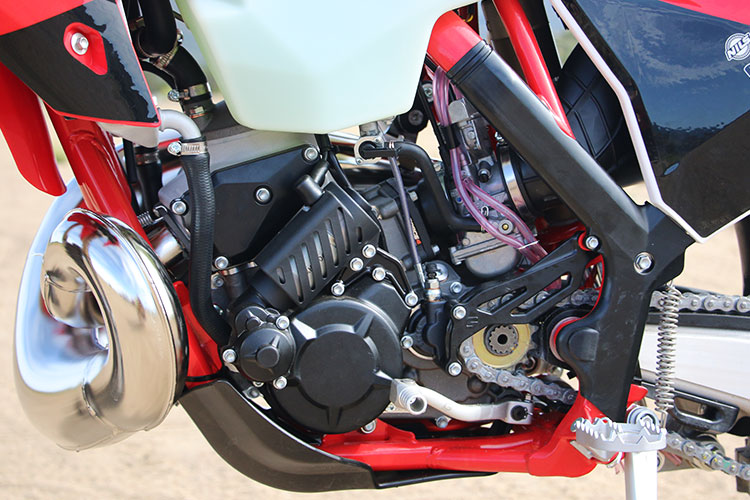
Everything on the chassis is brand new starting with a central backbone chromoly steel frame that is much lighter (claimed 21%) than the previous perimeter spar frame. It has less torsional rigidity and uses an isolated shock mount tower similar to KTM. The narrowing at the frame headtube also allows increased range of the handlebar turning as well. Starting with the 2.6-gallon gas tank the entire bodywork was redesigned. The seat is longer and slimmer with a more narrow profile going down towards the footpegs, which are also new. The sub-frame more narrow and houses the battery (no longer in the seat) and a side-access airbox with a spring-pressure attachment air filter arrangement. A lighter swingarm is also used and it has a redesigned chain tensioner system. The bikes come with a skid plate and handguards standard.
KYB suspension is a big change from the various brands (Marazocchi, Reiger, Sachs, Ohlins) Gas Gas has dabbled with in the past. The more familiar components are the 48mm AOS (air oil separate) closed chamber spring fork and a shock with high and low-speed compression adjustment. These are the same basic components that have been favored through all the variations of spring and air systems over the last 10 years.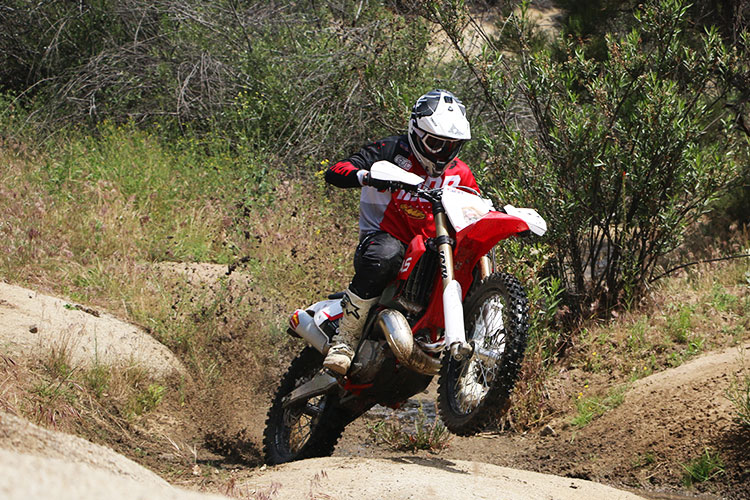
Wheels use Excel rims shod with Metzeler Six Days tires. Nissin brake components squeeze NG brake discs with standard sizing fo 260mm front and 220mm rear. Handguards are standard as are oversized handlebars. An aluminum kickstand tucks clear out of the way and retracts automatically, some like this and others hate it. The claimed weight of the EC is 231 pounds but we suspect that is a very dry weight.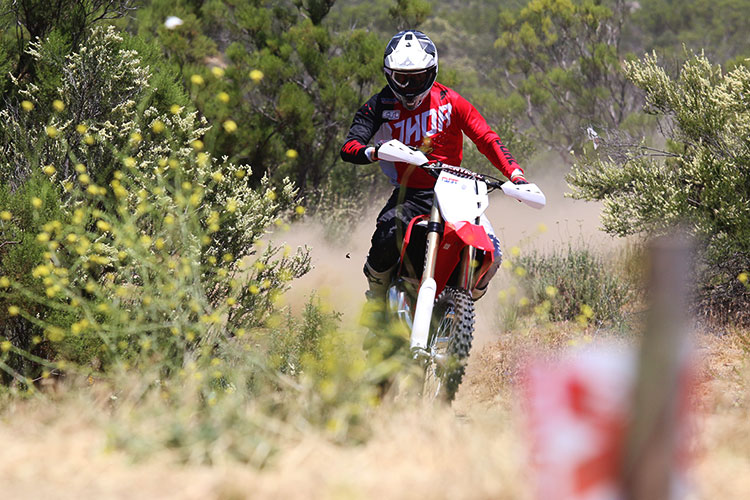
New for Gas Gas is the addition of the XC model. It is a slightly stripped down and powered up version of the 300 that will be offered for sale in the US and in Australia. The differences are simple with no lights or the associated wiring harnesses or switches. The headlight shell is replaced with a front number plate. The handlebar is a Renthal Twinwall with a clatter bend compared to the EC. And finally the exhaust is an FMF pipe that produces a more aggressive power delivery.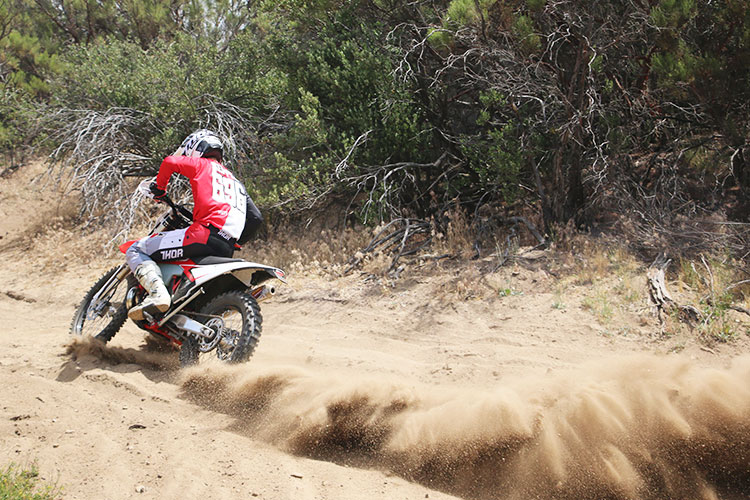
So what are they like to ride? Impressive. If you are doing any comparison to the 2017 machine, don’t. The new bike is not even comparable except on one plane. The Gas Gas torque and chug is still alive and well. Starting with the power, since it is the only thing comparable, it has been livened up and is what riders choose 300cc two-strokes for. Yet even in power the biggest news here is the reduction in vibration. Adding a headstay to the engine and attaching it to the frame plus we suspect a lighter crankshaft with a better balance seem to have paid off. And that is a good thing since some other brands have really focused on this point. Power is also the biggest difference between the EC and XC and it all comes down to the only difference between the bikes, the exhaust system. The EC has one of the flattest and most constant torque curves of any two-stroke. It makes a lot of torque right off idle and in comparison to some bikes does not make a ton on top. But it is always enough and it is always there. It is the kind of engine that you never need to use the clutch because it does not bog down. Or on the EC you are using it a lot to make the engine rev up quicker. By comparison the XC has a more lively throttle response with the same bottom torque and a faster pull through the power. Not knowing any better we’d say it felt like the XC had a different ignition with a lighter flywheel and a more aggressive curve though we were assured the ignitions were identical between the bikes. The other difference between the bikes was the use of a spark arrestor muffler on the EC bikes we tested (not standard).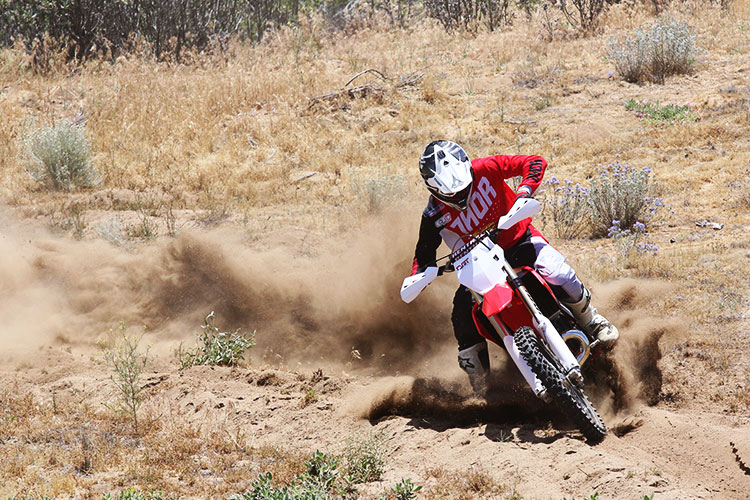
Neither bike was slow by any means but they both appreciated to be run a gear high. The roll-on was great and in the dry and low traction conditions we tested in–there would have not been a quicker way to accelerate. The XC never needed the clutch to bring the bike on the pipe but the EC wanted the rider to give it a little clutch for a quicker pick-up. Both bikes will rev out plenty far and have a tell-tale sign-off right after peak power. A proper rider would have already shifted. On technical sections where going slow and clutch work was required, the feel and control was good as expected, a Gas Gas trait since they were pioneers in the hydraulic clutch movement. But getting the adjustment of the lever just right seemed pretty critical as the light feel at the lever also makes it tough to feel exactly where the clutch pull starts. All the flywheel weight feel and smooth throttle to rear-wheel control prevented stalling and made tough sections easier. These bikes could be some of the most reluctant bikes to stall. Trail riders will just fall in love and racers will not be disappointed. Jetting on these bikes had been altered slightly with needle clip positions on some bikes and small drops in main and pilots on others due to the 3000 ft. altitude we were riding at.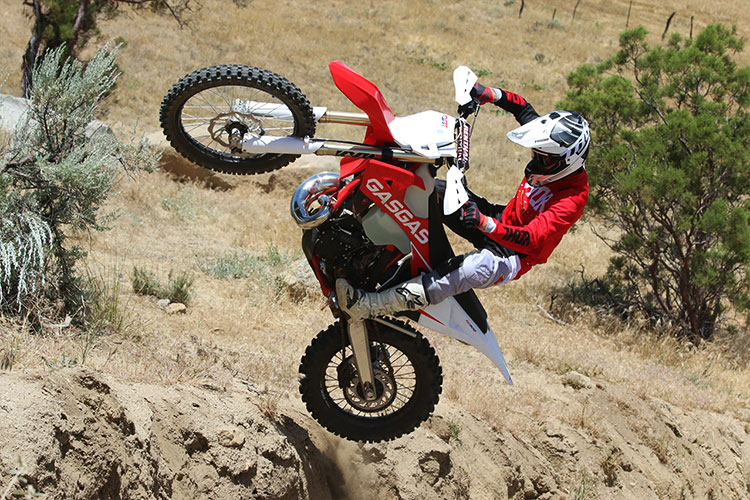
The two biggest changes to the bikes come in suspension performance and in how much more nimble the bike feels. And these go hand-in-hand. The layout is very compact but still roomy. It is as if they made the bike smaller underneath you but not cramped around you. The seat is much softer and since it rises a bit on the back it tells you to get forward in the turns but also allows taller riders a place to sit on the longish seat. New larger and grippier footpegs give great control through the feet and the bike is narrow through the middle. It bulges a little back along the subframe and riders who are sensitive to this might notice it. Forward of the footpegs the bike is thin and narrow especially for a 2.6-gallon tank.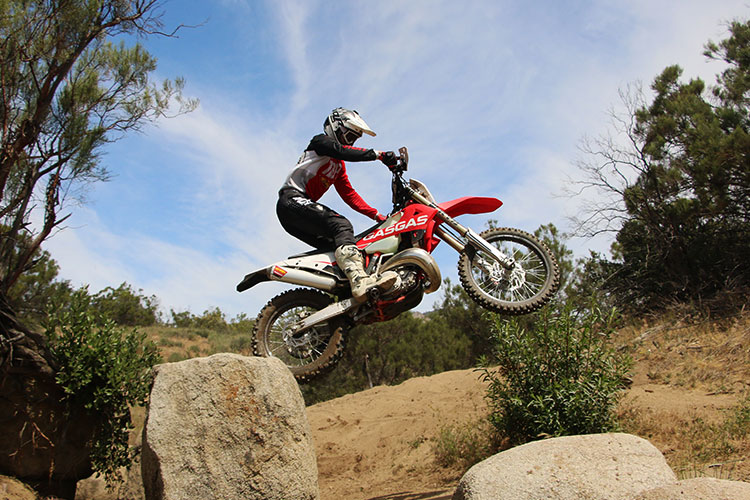
Weight wise the bike is just light enough feeling to be called light but just heavy enough to have a planted and stable feel as well. With bikes getting lighter and lighter they also can get a little dancy on the wheels and the Gas Gas has seemed to find a pretty good balance here. So in reality they only time you can feel any adverse effects of the weight was when the bike would get out of line and that was not very often. Where the old bike did a really good job of masking its weight, this one does not have to.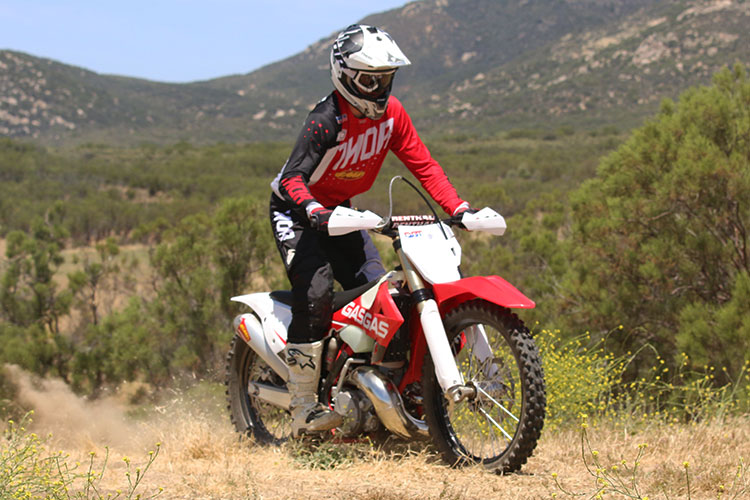
Simply put the suspension was excellent. So good that we didn’t feel the need to adjust anything, not even mess with the sag and we were splitting riding time between at least five different bikes. The biggest surprise was in the ability of the bike to be very supple on the small bumps and when settling in the turns, then have the bottoming control to really hit ditches or jump landings without any worry. It has a very progressive feel to it with way above average bottoming resistance. This performance is right up there with anything we have ridden but of course some back-to-back testing on more familiar terrain is what will really tell the tale. Of note is that there is no difference in the suspension between the EC and XC bikes nor did we feel like there would need to be based on how well it worked. The handling has the bike wanting to follow the front wheel with a planted stability, so the turning was confidence inspiring. And though there were not too many high-speed sections we did not have any instability on our short test. As you can tell from our pictures, there was no issue in throwing the bike around in the air or on one wheel…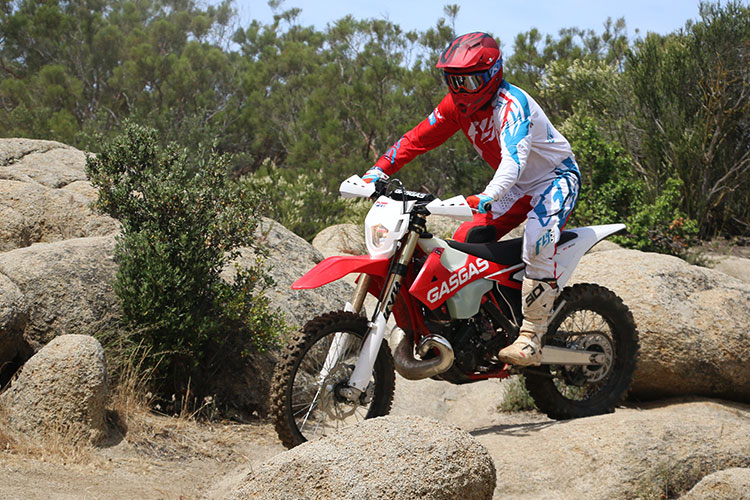
The only things that stood out was that the brakes could use some attention and the shifting was notchy. At least on our first rides early in the day on bikes that had very little time on them. And like most bikes the brakes seated in and became more powerful (they seemed a little soft in the morning) and the shifting got better in the afternoon with break-in. The front tire was good as was the rear under acceleration, but we were not happy with the feel under braking of the rear tire, a personal preference of course. 
Yes, we were impressed. Gas Gas has built a bike that excelled in every area it needed to while not losing focus on the torque aspect of its engine that really stood out. With the other two-strokes getting so much better in areas like weight, vibration, engine performance and suspension, it is good to know that the Gas Gas will not get left behind. Or even better, be a player offering another option to the class. And they are looking forward with a 200cc version and lots of other things in this market to come. The 2018 bikes should be at dealers starting in July with the EC 300 at $9299. Then the XC’s will follow. Finally the XC 200 should arrive in November at $8599.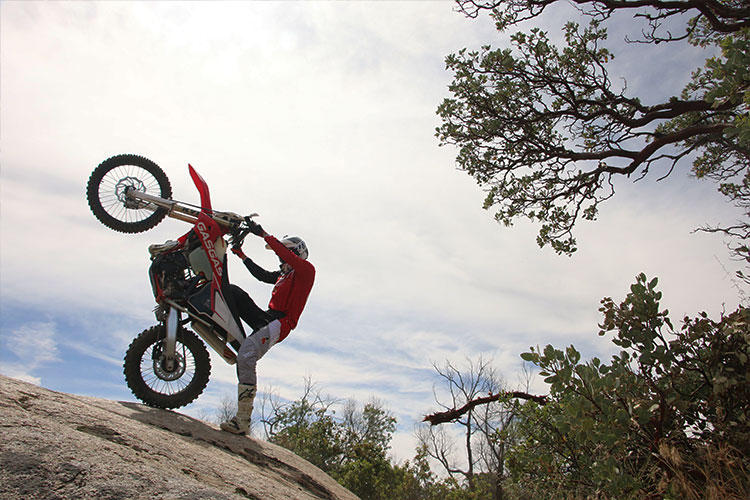
Support DBT by shopping through links below:


6 Responses to “Riding Impression: 2018 Gas Gas EC and XC 300”
Jimmy Lewis
Trust us this is a Gas Gas frame design that is very similar to KTM because that design basis works. Looking closely is does not appear to be the same welding or finish as a KTM frame. The swingarm looks very similar but it is the process that seems to be duplicated because it works.
Optimus Prime
Jimmy, you’re probably one of the most respected moto journalists ever. But come on, if I can put the frame guards, radiators, swing arm, foot pegs, triple clamps etc. from my 2010 KTM on the “new” GASGAS, what does that tell us? There’s no shame in WP selling frames to GASGAS, (lord knows the ’96 KX250 design they had been tweaking since 1999 was way behind the times).
If it walks like a duck, if it quacks like a duck, it must be…
Jimmy Lewis
I have not pried into where the frame is made. I have not tried switching parts nor do I care to. But when I look at it closely it does not look like the KTM frame, especially the welds. When something works, it will get copied.
Jimmy Lewis
We will need to ride the bikes back-to-back to see for sure. I would say from my one-day ride that the Gas Gas is very close and definitely back in the game. We rode in some tight but I’d like to put it in extreme enduro conditions to really determine.
Melvin Betancourt
I have a 2017, would it be worth switching to the 2018? I love my bike but it feels heavy and suspension
is harsh.
Jimmy Lewis
The improvement is beyond huge. The answer is YES!